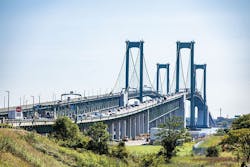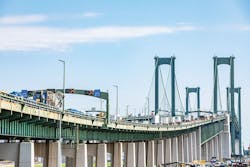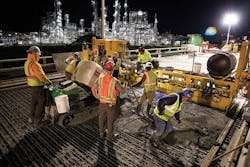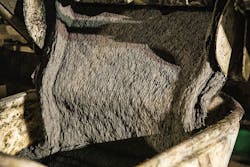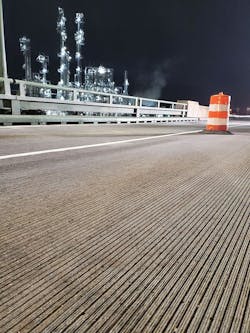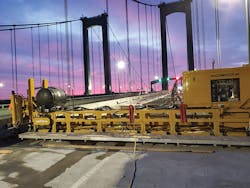Deck rehabilitation on the Delaware Memorial Bridge gives a historic structure another half-century of service life
The U.S. faces an unprecedented challenge in maintaining and rehabilitating its aging transportation infrastructure. Agencies in every state are looking for innovative ways to extend the life span of the existing bridges and maximize the efficiency of their limited budgets.
The recently completed Delaware Memorial Bridge (DMB) pilot project demonstrated a cost-effective solution that delivered a 50-year life cycle bridge deck rehabilitation with minimal traffic disruption. The DMB is a twin steel suspension bridge with a length of 10,765 ft and a vertical clearance of approx. 174 ft. It is a vital transportation link for commerce in the Northeast and connects the states of Delaware and New Jersey over the Delaware River. It is the southernmost fixed vehicular structure over the Delaware River and often sees over 80,000 vehicles crossing daily on I-295 and U.S. Route 40. The first was originally completed in 1951 and a second was added in 1969, making it the world’s second-longest twin suspension bridge with a total of eight lanes of traffic at that time. Today, the original suspension span carries the northbound traffic for I-295, whereas the newer span carries the southbound traffic.
In the fall of 2020, the Delaware River & Bay Authority (DRBA) installed the largest ultra-high performance concrete (UHPC) bridge deck overlay in North America on the bridge. The goal was to provide a long-lasting and resilient preservation method for the bridge with the added bonus of accelerating construction and minimizing traffic inconvenience during construction.
Time for a change
After 60 years of continued service, a deck condition assessment of the northbound bridge of the Delaware Memorial Bridge determined that a proper rehabilitation of the existing deck would significantly enhance the service life of the structure. DRBA considered several repair options such as a full deck replacement, UHPC overlays, or other traditional overlay materials such as latex-modified concrete (LMC). A life cycle cost analysis of the various repair techniques comparing their initial construction costs with their long-term life cycle costs concluded that the benefits of a UHPC overlay outweighed traditional overlay repairs or a full deck replacement. The condition of the existing deck, with a combined 25% delamination and deterioration, was still at the right age in its life cycle where a preservation solution with a watertight and durable overlay could extend its life expectancy another 50 years or more without a major repair intervention.
To validate industry installation techniques and construction methods, including traffic control management and the ridability of a UHPC overlay, the DRBA decided to perform a UHPC pilot project over two of the four lanes on two different sections of the northbound bridge and all four lanes in a third section. This project encompassed areas on the bridge deck representing the suspension, truss, and girder spans. For the DRBA, this decision reflected a larger trend in asset management and maintenance.
“For many transportation agencies, their best performing assets are often their toll bridges,” said Shekhar Scindia, DRBA Senior Project Engineer. “The toll revenues from these bridges help support and sustain other transportation assets for many of these agencies—more so, since several other modes of transportation such as air travel, transit, etc. have been severely affected by the pandemic. Since revenues have to be spread across other transportation assets and the maintenance and upkeep of all these assets poses a tremendous burden for many transportation agencies, these agencies have been seeking innovative solutions that help them manage their aging bridge inventory with smart investment in innovative new technologies and solutions.”
Following successful completion of the pilot project in November 2020, the DRBA is considering a full-scale UHPC overlay project on the northbound structure within the next few years. This project presents the possibility of saving significant public funds, while also extending the life of the bridge deck by 50 years or more.
A little UHPC history
In North America, for over a decade UHPC has typically been used in accelerated bridge construction as field cast connections for precast elements to either replace or install new bridge decks. Only recently has UHPC been placed as a thin bonded overlay for bridge structures. Most of these overlay projects have been initial pilot projects by state DOTs and other highway agencies for proof of concept. However, none of these projects were large enough to confirm that the UHPC industry in the U.S. would be able to complete a 10,765-ft full-scale bridge project across four lanes with minimum traffic interruption. In comparison, this UHPC repair method is proven and very common in Switzerland, where over 200 overlays have been successfully in service over the past 15 years including a twin 1.3-mile structural overlay on the Chillon Viaduct.
By just removing the top chloride infected layer of the aging deck concrete (usually 2-3 in. thick) and replacing it with a UHPC overlay, the life of the same bridge deck can be extended by several decades into the future. UHPC not only has higher strength, better impermeability, and better bond strength to the old concrete, it also presents the advantage of completing the required work of rehabilitating the bridge deck in a fraction of the time it would take to perform a full deck replacement. The impact on traffic, which is always a huge concern for bridge agencies, especially on major bridges that carry thousands of vehicles every hour, is thereby minimized.
When compared to conventional concrete or other traditional overlay materials such as LMC, UHPC bears a higher compressive strength, tensile ductility, bond development, and enhanced durability performance. These material properties are a direct result of the low permeability pore structure and the addition of high-strength steel fibers. When installed properly with suitable paving equipment and an experienced workforce, UHPC overlay construction methods can minimize traffic interruptions and shorten total construction time, offering an accelerated solution during the initial construction process. The Federal Highway Administration has been encouraging state DOTs to consider UHPC for bridge preservation and repair through its latest Every Day Counts (EDC-6) program through the Center for Accelerating Innovation.
Collaboration
During the development of the UHPC pilot project, the DRBA engaged WSP to perform the design of the overlay on the suspension, truss, and girder sections of the bridge. Contractors bidding on the project were required to submit a qualifications questionnaire demonstrating that they met minimum requirements for UHPC overlay placement experience and confirming they were capable of furnishing a self-propelled fully automated paving machine that spreads, consolidates, and finishes the UHPC overlay and that is specifically designed and constructed for placing UHPC overlays. The general contractor on the pilot project was J.D. Eckman Inc., who subcontracted the mixing, transporting, paving, and finishing of the overlay to the speciality contractor UHPC Solutions North America. The material selected was a LafargeHolcim Ductal overlay formulation with 3.25% steel fibers reaching 12,000 psi within 48 hours. This team of professionals worked well together during the construction of the project and were able to prove that 90 cubic yd of UHPC overlay at a width of 26 ft and a depth up to 4 in. can be installed within an eight-hour shift. The result was a grinded and grooved riding surface, very similar to one that would be delivered by a newly constructed concrete deck.
To date, this efficient installation time is a new record for the U.S. UHPC industry. In addition, the feedback and collective experiences from all members of the project team strengthened the confidence that this pilot project can easily be scaled up for a successful and even more economical full-scale preservation of the northbound structure’s deck within the next few years.
Some Perspective
The choice to engage WSP on this project was a reflection of the firm’s position on proposing innovative ideas to aid agencies in economically managing their assets.
“We anticipate trends in order to propose innovative ideas for our clients to meet their business objectives,” said Andy Foden, Senior Bridge Evaluation and Technology Manager for WSP. “UHPC provides durable construction, maintenance, and preservation solutions. For this project, we listened to and understood DRBA’s need to quickly rehabilitate the bridge deck on the first structure to minimize impacts to their customers, while also providing a durable and cost-effective solution. After comparing multiple alternatives using life cycle cost analysis, the decision to recommend moving forward with the UHPC solution was clear.”
Contractor UHPC Solution North America, which specializes in these types of overlays, very quickly saw the bridge as an ideal candidate—notably with regard to the anticipated challenges the contractors and their crews would face once the work began.
“This project had unique challenges with the schedule for lane closures driving our mixing and placement equipment, limited lay-down and storage area on the bridge itself, and needing to open the finished overlay within 48 hours,” said Gil Brindley, P.E., Director for UHPC Solutions North America. “With a schedule this tight, we were driven to collaborate and cooperate with everybody on the project team to get the work done on time.”
UHPC Solutions operated two on-site mobile batching plants capable of producing the required volume of material, which was then paved using specially developed thin lift UHPC paving equipment by GOMACO Corp. This newly developed self-propelled thin lift paver is capable of paving steep slopes and lanes with crowns up to 30 ft. Its variable and monitored frequency ranges ensure proper consolidation of UHPC even with slopes over 10%. The combination of this thin lift paving equipment with an experienced workforce was essential to installing a successful overlay and shortening the total construction time of the bridge rehabilitation project. To achieve ridability and smoothness requirements, the finished UHPC surface was diamond ground and grooved. In total, 328 cubic yd of UHPC covering an area of 25,500 sq ft were paved for the 1,000-ft pilot project.
Key Takeaways
As evidenced by the success of the DMB pilot project, UHPC overlays for existing bridge decks offer an economical and long-lasting preservation solution for bridge owners. Other highway agencies and bridge owners should be encouraged to consider this rehabilitation methodology to significantly extend the service life of their bridge decks. By collaborating and sharing experiences during the evaluation of a pilot project, the repair solution for the scaled-up project can become even more economical in the short-term—during construction—but more importantly in the long-term by eliminating future maintenance costs.
DRBA’s Scindia explained: “Using UHPC was absolutely a game changer. The benefits of this project will be realized by our children and grandchildren. Bridge rehab projects will be quicker, will impact traffic less, last much longer than full deck replacements, and stretch public capital improvement dollars.”
Acknowledgments: The authors thank the DMB UHPC pilot project team, including the Delaware River & Bay Authority, WSP, J.D. Eckman Inc., UHPC Solutions North America, and LafargeHolcim, for their collaborative partnership throughout the construction and post evaluation of this project.
